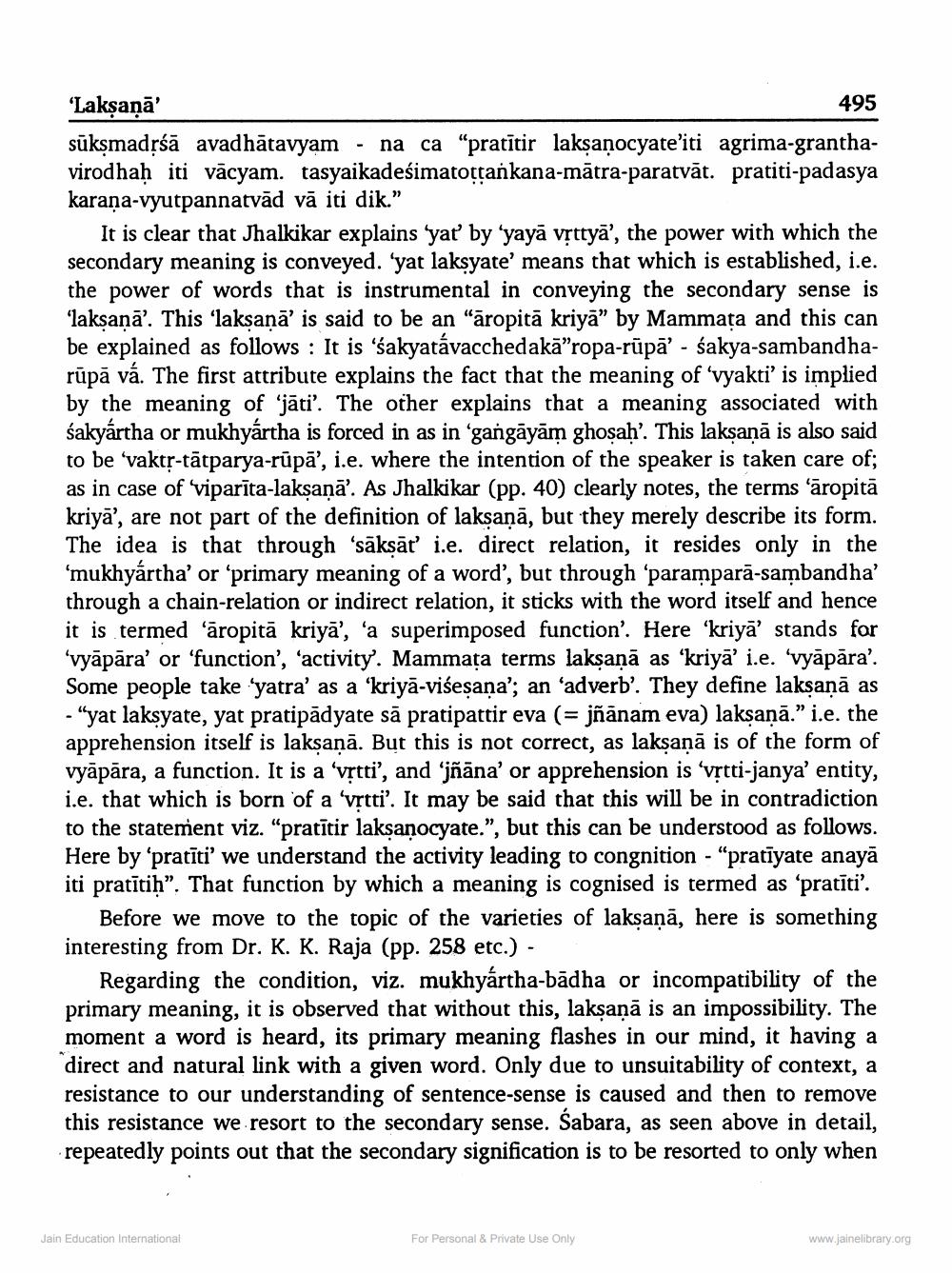________________
'Laksana'
495 sūksmadrśā avadhātavyam - na ca "pratitir laksaņocyate'iti agrima-granthavirodhah iti vācyam. tasyaikadesimatottankana-mātra-paratvāt. pratiti-padasya karana-vyutpannatvād vā iti dik.”
It is clear that Jhalkikar explains yať by 'yayā vrttyā', the power with which the secondary meaning is conveyed. 'yat laksyate' means that which is established, i.e. the power of words that is instrumental in conveying the secondary sense is 'laksaņā'. This 'laksaņā' is said to be an "āropitā kriyā” by Mammata and this can be explained as follows : It is 'sakyatávacchedakā”ropa-rūpā' - sakya-sambandharūpā vá. The first attribute explains the fact that the meaning of 'vyakti' is implied by the meaning of 'jāti'. The other explains that a meaning associated with sakyártha or mukhyártha is forced in as in 'gangāyām ghosah'. This laksanā is also said to be 'vaktr-tātparya-rūpā', i.e. where the intention of the speaker is taken care of; as in case of viparīta-lakṣaṇā'. As Jhalkikar (pp. 40) clearly notes, the terms āropitā kriya', are not part of the definition of laksanā, but they merely describe its form. The idea is that through 'sākṣāt' i.e. direct relation, it resides only in the 'mukhyártha' or 'primary meaning of a word', but through 'paramparā-sambandha' through a chain-relation or indirect relation, it sticks with the word itself and hence it is termed 'āropitā kriyā', 'a superimposed function'. Here ‘kriyā' stands for 'vyāpāra' or 'function', 'activity'. Mammața terms laksaņā as 'kriya' i.e. 'vyāpāra'. Some people take 'yatra' as a 'kriyā-višeşana'; an 'adverb'. They define laksaņā as - "yat laksyate, yat pratipădyate să pratipattir eva (= jñānam eva) laksanā.” i.e. the apprehension itself is laksanā. But this is not correct, as laksaņā is of the form of vyāpāra, a function. It is a 'vrtti', and 'jñāna' or apprehension is ‘vrtti-janya' entity, i.e. that which is born of a 'vrtti'. It may be said that this will be in contradiction to the statement viz. "pratitir laksaņocyate.", but this can be understood as follows. Here by 'pratīti' we understand the activity leading to congnition - "pratīyate anayā iti pratītih”. That function by which a meaning is cognised is termed as ‘pratīti'.
Before we move to the topic of the varieties of lakṣaṇā, here is something interesting from Dr. K. K. Raja (pp. 258 etc.) -
Regarding the condition, viz. mukhyártha-bādha or incompatibility of the primary meaning, it is observed that without this, laksanā is an impossibility. The moment a word is heard, its primary meaning flashes in our mind, it having a "direct and natural link with a given word. Only due to unsuitability of context, a resistance to our understanding of sentence-sense is caused and then to remove this resistance we resort to the secondary sense. Sabara, as seen above in detail, repeatedly points out that the secondary signification is to be resorted to only when
Jain Education International
For Personal & Private Use Only
www.jainelibrary.org




